For video creators, YouTube is often the first platform that comes to mind. But is it the best fit for you, or should you check out some YouTube alternatives?
Many creators, both new and experienced, look for alternatives to YouTube for better earnings and more control over their content across various video hosting platforms.
But is it worth looking at YouTube’s competitors? Let’s check out some of the best video websites to see if they fit your creative needs.
How to Choose the Right YouTube Alternative
Before we jump into the list of YouTube alternatives, here’s what to consider when picking the right one for you:
- Define Your Content Type — Choose a platform that matches your content. Are you sharing regular videos, short clips, or live streams? This is important for finding the right YouTube alternative.
- Know Your Audience — Understand where your audience hangs out and how active they are. YouTube has a big user base, but does it attract the younger crowd you want?
- Evaluate Monetization Options — Look for platforms that fit your monetization goals, like when you make money on YouTube. Are you after ad revenue, subscriptions, or donations?
- Think About Content Ownership and Control — YouTube takes a broad license to your videos. If you want to build your brand, find alternatives that let you keep more control and ownership.
- Check the Platform’s Engagement — To grow as a creator, you need to connect with your audience. Choose video sites with strong community features like comments, live chat, and sharing tools to boost interaction.
- Review Moderation and Policy — If you’re looking for alternatives due to YouTube’s strict rules, find platforms that offer easier guidelines and fewer restrictions.
- Look for Ease of Use & Integration — If you’re just starting, pick alternatives with a user-friendly interface, simple uploads, and seamless integration with other platforms.
- Check Platform Reliability — You don’t want technical issues ruining your content, right? Then, make sure the platform delivers good video quality and fast streaming.
- Look at Platform Reputation — Research the platform’s reputation. Avoid those with a bad image and focus on evolving platforms with clear long-term goals to help build your online presence.
Related: How to Be a YouTuber
13 YouTube Alternatives for Content Creators
Here are the suggested YouTube channels for video creators in any niche for 2025:
1. Dailymotion
- Ideal for: Video creators looking for simpler monetization and less competition.
Looking for a YouTube alternative that welcomes new video creators? Check out Dailymotion.
As you know, YouTube requires 1,000 subscribers to start earning money. Dailymotion lets you monetize with just 1,000 views . Plus, you can easily make money from video rentals.
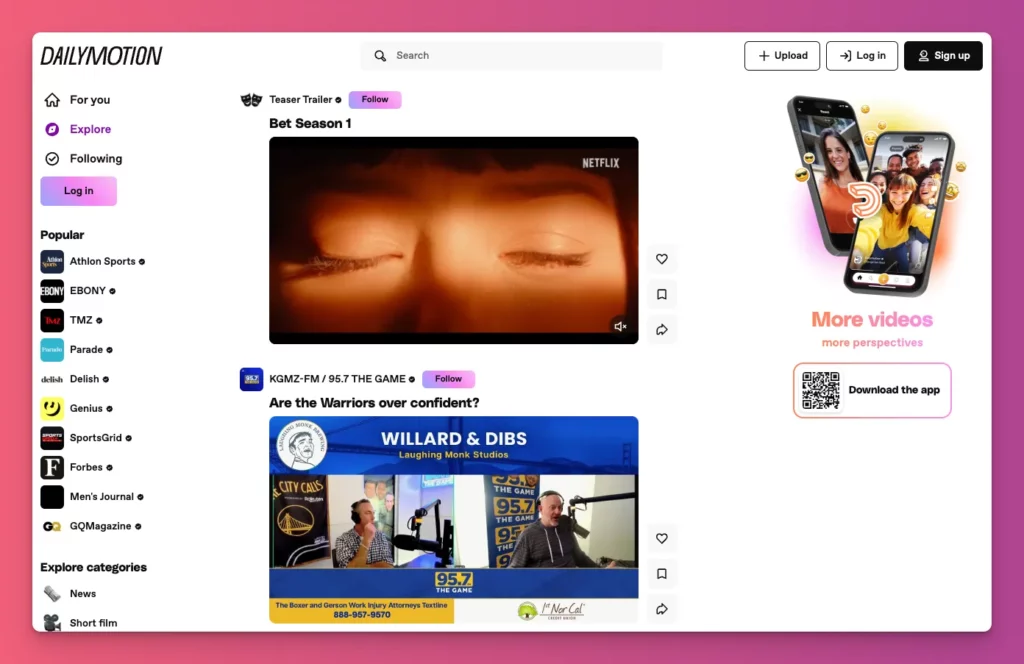
But keep in mind, Dailymotion has a 2-hour limit on video length and a 4GB size cap. But if you’re just sharing regular videos, these limits won’t hold you back.
Pros:
- Less Competition — You can stand out more easily in specific niches.
- Better Monetization — You enjoy options like ads, pay-per-view, rentals, and direct sales that YouTube doesn’t offer.
- Less restrictive — Their content moderation is more relaxed, giving you more room to be creative.
- Familiar UI — There’s no steep learning curve, and the workflow is similar for those moving from YouTube.
Cons:
- Audience size and reach — With only 350 million users, the views and engagement can’t match YouTube.
- View Requirements — You need at least 1,000 views to start earning money.
Read Also: How to Get More Views on YouTube
2. TikTok
- Ideal for: Short video creators looking for chances to get famous quickly with viral content
TikTok is a unique YouTube alternative. And it has even changed how YouTube shares videos with features like YouTube Shorts.
You heard it right. TikTok has changed how people watch videos, focusing on short, vertical clips that we can easily swipe through.
And that’s not all. TikTok’s power comes from its algorithm that can turn new creators into stars in just a few days, especially with the younger viewers.
Pros:
- Beginners Friendly — A faster path to viral growth for new or niche creators.
- Great unique features — You can use interactive options like duets, stitches, and live streams for real-time engagement.
- Unique algorithm — TikTok learns user preferences quicklyand gives them personalized content suggestions.
- In-app creative tools — You can use editing tools, special effects, AR filters, and sounds to make great videos.
Cons:
- Monetization on TikTok — Requires 10,000 followers and 100,000 video views in 30 days for Creator Rewards.
- Strict content moderation — Tough rules can lead to shadow banning without notice.
- Trend-focused community — Videos can go viral quickly, but for lasting connections, YouTube is better.
3. Vimeo
- Ideal for: Content creators focusing on professional content with customizable video player and direct sales as the monetization strategy.
It’s hard to overlook Vimeo as one of YouTube alternatives. It’s been around since 2004 and has gained popularity for its high-quality videos and vibrant community of creators.
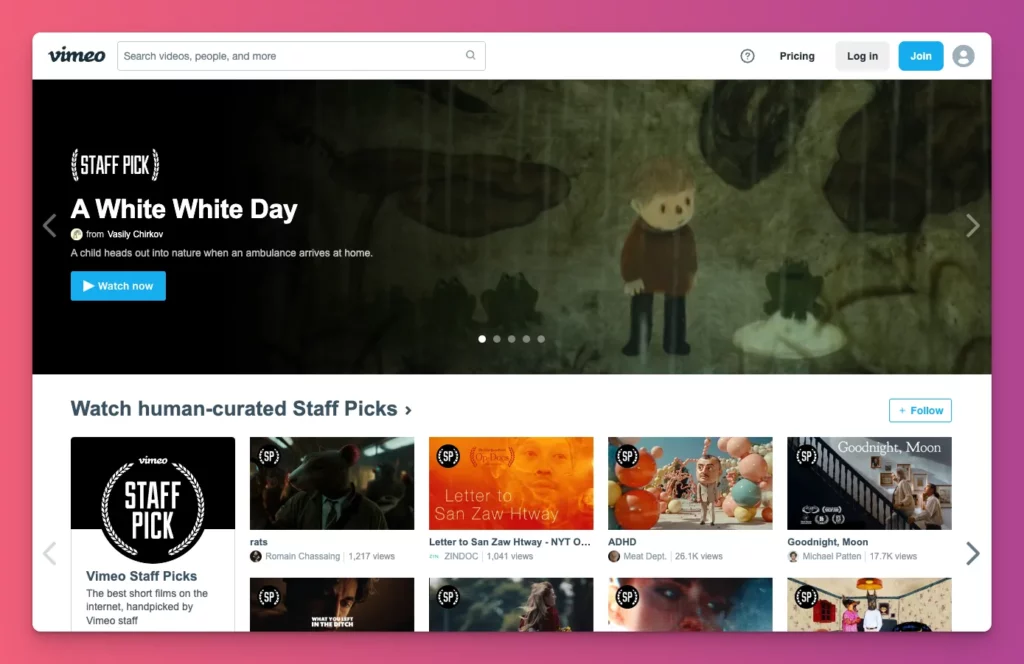
Vimeo focuses on a specific audience: people who love artistic and professional video content. If your videos fit this niche, think about using this platform.
And for content creators wanting to share 4K videos or needing advanced privacy options with a customizable player, Vimeo is the best choice.
Pros:
- Ad-free viewing — If you don’t want your viewers to get tired of ads on YouTube, Vimeo is a great choice.
- High video quality — Supports up to 8K resolution for paid users, appealing to those who value visual fidelity.
- Enhanced privacy — Content can be protected with passwords and domain restrictions, great for exclusive material.
- Direct-to-fan monetization — Generated revenue through rentals, sales, and subscriptions with custom pricing.
Cons:
- Limited organic discovery — Views primarily come from direct sharing rather than internal discovery tools.
- Free user limits — Advanced features and larger uploads require a paid subscription.
4. Reels
- Ideal for: Influencers or established Instagram content creators who want to find alternative to YouTube Shorts.
“Instagram Reels? An alternative to YouTube?” That’s right. Most video content is now viewed on smartphones, with 94% of users holding their phones vertically.
With that in mind, don’t limit yourself to standard videos. Stay updated on trends and think about making vertical videos to attract viewers. It leads to more views and better engagement.
If you believe your audience is more on Instagram than YouTube, try making short videos for Reels. It could be a smart move.
Pros:
- Massive audience — Instagram has 1.74 billion users, with Reels reaching over 726 million monthly.
- High engagement — Reels have a 1.23% engagement rate, exceeding photos at 0.70% and carousels at 0.99%.
- In-app creative tools — Create videos easily with Instagram’s AR effects, speed control, and alignment features.
- Business-friendly — A popular platform for brands, enhancing opportunities for partnerships and sponsorships for influencers.
Cons:
- More niche audiences — Attracts niche audiences, mainly in beauty, fashion, and lifestyle, unlike YouTube’s broader reach.
- Limited monetization options — No ad sharing or subscriptions, so income relies on sponsored posts, partnerships or affiliate.
- Limited content type — Not ideal for all content types, posting tutorial content on Instagram is more challenging than on YouTube.
5. Twitch
- Ideal for: All streamers including gaming streamers, musicians, IRL streamers, and more
Looking for a YouTube alternative for live content? Then, you can try Twitch, one of the best streaming platforms out there.

With this alternative to YouTube, you can connect to your audience directly through chat and emotes. It’s like YouTube Live. But it’s more about building a community, especially for gamers.
Unlike YouTube, which relies on search and recommendations for on-demand content, Twitch is about real-time interaction from their live streaming viewers.
Pros:
- Live streaming — Twitch outshines YouTube Live for niche audiences, especially gamers.
- Community first — Build strong connections and personal brands. Viewers can support creators through subscriptions, Bits, and donations.
- Easy monetization — You can earn from subscriptions and Bits immediately, making Twitch a straightforward alternative to YouTube.
- Interactive features — Unique tools like Raids, channel Points, and collaborative streams enhance the experience.
Cons:
- Live Streaming Only — Not ideal for evergreen or searchable on-demand videos.
- Low Video Quality — Limited to 1080p, while YouTube supports up to 8K.
- Limited Monetization — Needs a loyal audience to make good money from subscriptions or donations like those top Twitch streamers.
6. Kick
- Ideal for: All streamers in all niches looking for better revenue sharing options.
Are you looking for a strong alternative to YouTube for streaming? And do you you also want to avoid Twitch for better revenue and less content moderation? Then, you can check out Kick.
Kick is one of YouTube’s competitors known for its generous monetization and creative freedom.
No ad-driven or algorithm-heavy ecosystem. Kick is built for creators. With an incredible 95% revenue share on subscriptions, it beats YouTube and Twitch hands down.
Pros:
- Higher revenue — You can enjoy a 95% revenue split, much better than YouTube’s ad model.
- No ads — Your viewers can watch without interruptions, eliminating reliance on ad income.
- Multicast capability — Simulcast on multiple platforms to broaden your audience and earnings.
- Less competition — Fewer creators on Kick compared to Twitch, making it easier to stand out.
Cons:
- Audience size — With 57 million users, it’s smaller than YouTube, limiting reach.
- Reputation — Hosts controversial content with less moderation. This might make some creators not want to join.
- Limited monetization options — Mainly depends on subscriptions and tips, with no money coming from ads.
Read Also: How Much do YouTubers Make?
7. Rumble
- Ideal for: video creators seeking YouTube alternatives with more freedom, faster monetization, or diverse topics.
If you’re passionate about sensitive topics and tired of being shadowbanned on YouTube, Rumble is your go-to platform.
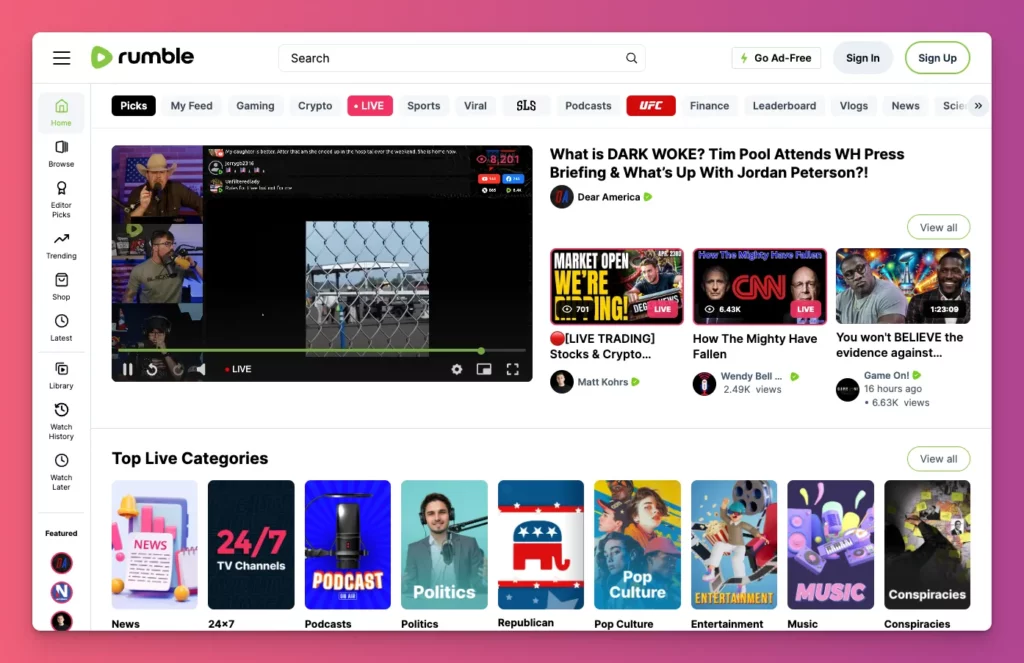
While Rumble takes a strong stance against hate speech, copyright violations, and explicit criminal content, it’s more flexible with political discussions and news commentary.
The real draw is its ease for new creators to start earning money, with up to 60% ad revenue share, direct subscriptions with 100% earnings, and video licensing opportunities.
Pros:
- Monetization for All — Start earning immediately with no major obstacles.
- Licensing opportunities — You can also earn from licensing viral or newsworthy videos.
- Minimal content moderation — Feel free to upload niche videos, even controversial ones, making it a good YouTube alternative.
- Custom ad rates — Set your own rates based on your content’s worth.
Cons:
- Limited Features — Still lacks important tools like analytics and editing.
- Basic Algorithm — The system is simpler than YouTube’s, which may limit content promotion.
- Challenges with Brand Recognition — Brands often favor established YouTube creators.
8. Facebook Live
- Ideal for: content creators with established followings on Facebook, focusing on live streaming content.
Facebook isn’t a video site like YouTube. It’s a social media platform where people share their lives through photos and videos. So why is it seen as an alternative to YouTube?
Well, it’s one of the biggest social media platforms, with 3.07 billion active users. Plus, Facebook Live is a big deal. Even though its growth has slowed, it still commands a lot of attention with 66 million total hours watched.
And let’s not forget, they offer various monetization options for content creators who want to take their content to the next level, from Facebook Stars to subscriptions.
Pros:
- Audience size — Facebook has a huge built-in audience and strong engagement, ideal for viral content.
- Awesome engagement features — The global audience actively engages through shares, reactions, and donations like Facebook stars.
- Streamlined Monetization — Meta simplifies earnings for creators, allowing profit from various content types, including live videos.
- Fewer music restrictions — Facebook permits certain songs during live streams, as long as music isn’t the main focus.
Cons:
- Limited Customization — Facebook Live streams can feel overly branded, limiting personalization for creators.
- Shorter Stream Time — Facebook Live caps streams at 8 hours, while YouTube allows up to 12 hours, affecting live donations.
- Lower Video Quality — Facebook Live streams at a maximum of 1080p HD, while YouTube offers up to 8K resolution.
9. Playeur
- Ideal for: content creators who prioritize privacy and want flexible options for monetization and control over their content.
Playeur is a YouTube alternative with better revenue sharing for creators. You can start earning from day one through subscriptions and Playeur Plus.
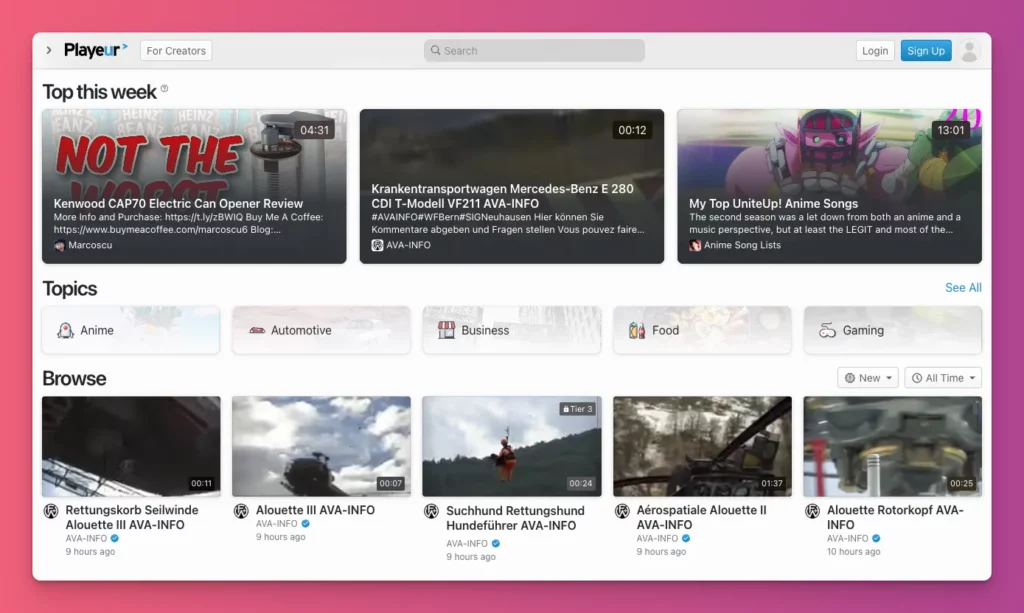
Gift subscriptions and Ultra Chat offer 85% revenue, compared to YouTube’s 70% from Super Chat.
The platform, previously Utreon, syncs YouTube content using the public API. But you still need to grow followers on both platforms.
Pros:
- Higher Revenue Sharing — You can earn 85% from live streaming and up to 90% from subscriptions.
- Start Earning Immediately — No need to wait for views or subscriptions to earn money.
- Direct Sync — Import and sync YouTube content to minimize disruption. It can be tricky but effective.
- Less Strict Moderation — Want to discuss tough topics like politics and tech? You can do it.
Cons:
- Smaller Audience — Growth is slower compared to YouTube.
- Limited Content — A smaller library may lead to less viewer engagement.
- Monetization Challenges — Fewer users mean lower earnings, especially for new creators.
10. DTube
- Ideal for: Video creators who are looking to earn money from cryptocurrency and blockchain.
If you’re seeking a YouTube alternative beyond major platforms, DTube is a great choice.
DTube stands out by using blockchain, allowing creators to earn cryptocurrency and promoting free speech without ads.
This platform generates revenue through community support, rewarding you with DTube Coins based on engagement with your videos. The more interaction your content receives, the more you can earn.
Pros:
- Creative freedom — You can enjoy total creative freedom without censorship, ideal for controversial topics.
- Decentralized — You can create content on sensitive issues without fear of removal.
- No Ads — Viewers have a smooth experience, and you earn crypto rewards instead of ad revenue.
- No steep learning curve — The interface is similar to YouTube, making it easy to learn.
Cons:
- Audience Size — This platform has about 245,860 visits a month, much less than YouTube.
- Crypto Earnings — Earning with crypto can be exciting but is risky and confusing for beginners.
- Less Advanced Algorithm — The algorithm can make it hard for new creators from gaining visibility.
11. Odysee
- Ideal for: Tech-savvy content creators who value decentralization, crypto rewards, and free speech.
If you’re a content creator looking for a unique YouTube alternative, you can check out Odysee.

It runs on the LBRY blockchain. This means you can discuss a bit controversial topics with less risk of censorship or sudden removal of your content.
How about monetization? You can earn LBRY Credits (LBC) when viewers interact with your videos, so you won’t need ads.
Pros:
- Decentralized — Your content stays safe from removal or suppression by any central authority.
- Blockchain Monetization — You can earn through engagement, tips, and subscriptions. No ads needed.
- Privacy-Focused — No targeted ads or intrusive tracking for your viewers.
- Content Persistence — Your videos remain accessible, even if Odysee is geo-blocked or taken down.
Cons:
- Smaller Audience — The reach is limited compared to YouTube; fewer users are on decentralized platforms right now.
- Crypto Confusion — Monetization can be tricky for newcomers and is affected by market fluctuations.
- Development Issues — Expect some glitches and payment hiccups as the platform is still evolving and less stable than YouTube.
12. Bitchute
- Ideal for: video creators who have unique, niche, or controversial perspectives and prefer less moderation.
Talking about social issues or political events can sometimes result in your content getting shadowbanned on YouTube. This means it won’t reach as many people.
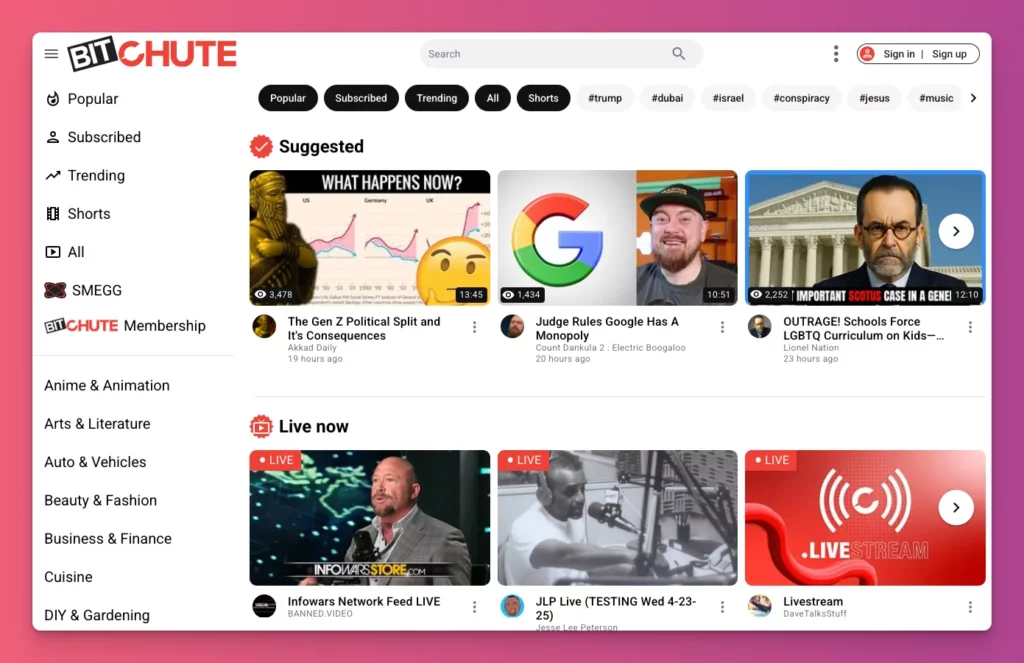
And if you often face moderation issues while creating videos on controversial topics that you are passionate about, think about trying BitChute.
BitChute was launched in 2017 as a response to the frustrating takedowns and demonetization that many YouTubers face.
Pros:
- Less content moderation — A great YouTube alternative for free speech with minimal moderation.
- Creator-driven monetization — You can focus on content creation and earning through audience support rather than ads.
- Genuine Appreciation — More views lead to better quality. No algorithms push content based on user history.
- Similar UI with YouTube — Easy navigation for creators and viewers due to a familiar layout.
Cons:
- Small Audience — With 28 million monthly visits, growing as a creator is challenging compared to YouTube.
- Poor Video Quality — Uploads limited to 480p and 2 GB, below other platforms’ standards.
- Fewer Ways to Earn — Limited monetization options compared to YouTube’s ads and memberships.
### 13. Alugha
- Ideal for: Creators who want one video to reach many language groups—multiple uploads needed.
Bernd Korz, Alugha’s founder, often got requests to translate his videos on YouTube. But, keep on reuploading was hard. That’s why he came up with Alugha, a unique YouTube alternative.
Unlike YouTube, Alugha’s core includes multilingual features. You can upload videos once and use the browser-based “Dubbr” studio to transcribe, translate, and record voice-overs seamlessly.
Alugha lets you control monetization. You can lock content and manage sponsorships without worrying about watch hours or ad revenue. It’s a great alternative to YouTube to consider.
14. Gank
- Ideal for: Any content creators who want to earn more from membership, donation and merchandise sales.
If you’re a video creator who wants a YouTube alternative that focuses on monetization and community building, you should check out Gank.
Gank is a membership platform. So, yes it might be not a full replacement for YouTube. But it can be a great support to your growth as a content creators.
Gank helps creators earn money straight from their audience. It offers flexible options like donations, memberships, exclusive content, digital services, and commissions for custom work.
Pros:
- Monetization from day one — Earn through donations, memberships, pay-per-view, commissions, and digital product sales.
- No minimum subscribers or views — Start earning immediately, unlike YouTube’s Partner Program.
- Flexible content options — Share exclusive videos, photos, or sell services and merchandise.
- Commission feature — Offer custom work and connect with fans easily through a dedicated tab.
- No platform fees for basic use — You can keep your earnings with the basic features of Gank as a membership platform.
- Great Mobile app — Manage your creator business on the go with iOS and Android.
Cons:
- Audience size — It is smaller than YouTube’s global reach, but it is growing.
- Not a video-sharing platform — If you are looking for a video-sharing platform with a UI like YouTube, Gank might not be for you.
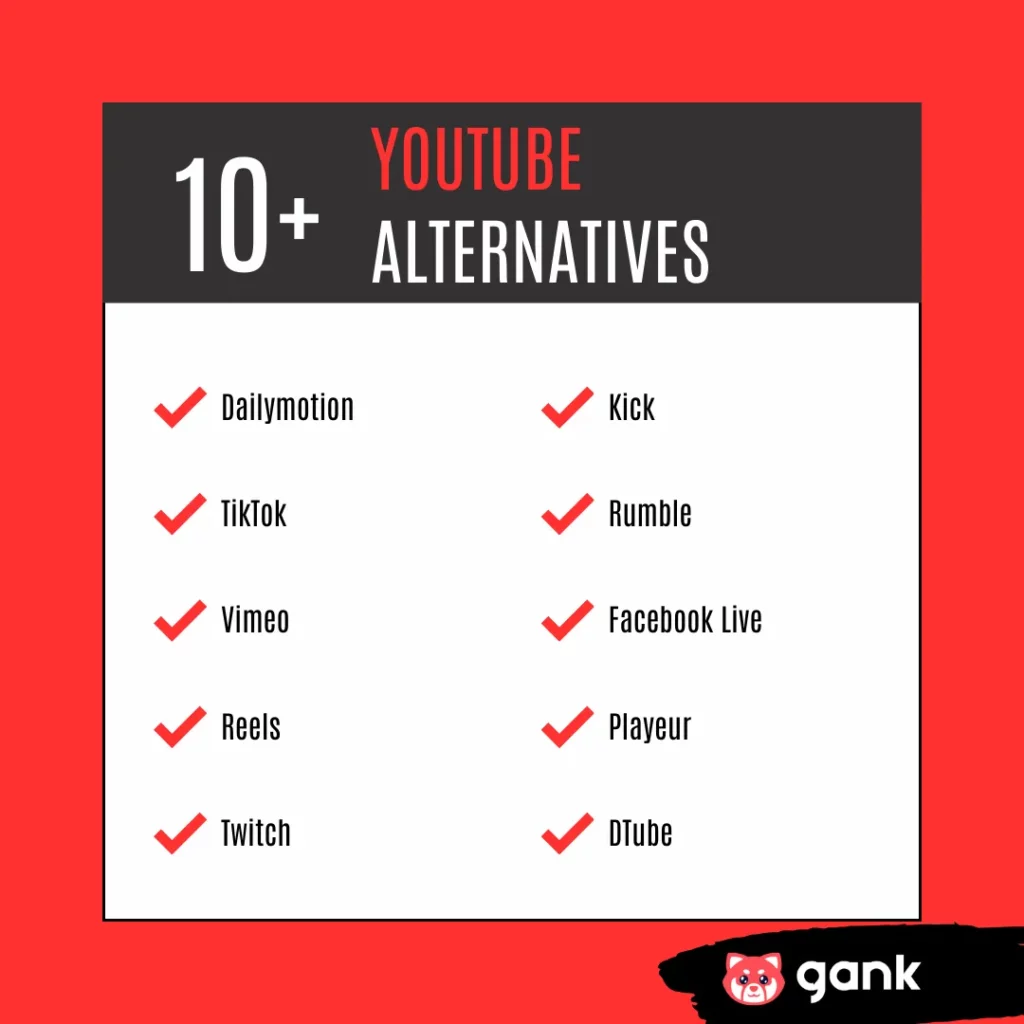
Why Look for Alternatives to YouTube?
YouTube is a leading streaming platform with a 12% share of the market. So, looking for alternatives isn’t a must. But if you do, here are some reasons to consider:
1. Too Many Ads Issues
Many think YouTube has too many ads. Even without monetization, ads may still appear, impacting creators’ viewer trust. For an ad-free experience, trying a YouTube alternative is a good idea.
2. Sudden Algorithm Changes
Every platform has rules, and they change. But YouTube changes the most. Its algorithm and moderation policies can disrupt your views and engagement. That’s why many creators look for YouTube alternatives.
3. Strict and Unclear Content Policies
Many creators look for alternatives to YouTube due to its strict content rules, which can result in removals or bans risking their work. Challenging these decisions often fails.
To avoid censorship, many prefer alternatives to YouTube like Rumble and Odysee that have more lenient policies and are popular for censorship-resistant content.
4. Low Revenue Share
If you’re okay with 55% of ad revenue, YouTube could work for you. If not, consider alternatives like Kick, which offers 95% revenue sharing, making YouTube less appealing for live streamers.
5. Tough Requirements
YouTube sees over 2.6 million daily uploads. It’s challenging for new creators to gain visibility. To join the Partner Program, 500 subscribers are needed. But, ad revenue requires at least 1,000 subs.
This makes many creators wonder if ad revenue sharing works. That’s why many are checking out YouTube alternatives with different monetization options.
6. Content Control
Content creators explore alternatives to YouTube due to ownership and control concerns. While you retain copyright, YouTube has the rights to use and profit from your work. Remember, deleting videos doesn’t remove copies from their servers.
7. Increased Risk of Burnout
With over 66 million YouTubers, competition is intense. Many creators invest over 100 hours monthly in scripting, filming, and editing. So, when someone like Matthew Patrick from Game Theorists considers leaving YouTube, it highlights the challenges creators face.
8. Diversified Platforms
77% of creators worry about relying too much on platforms like YouTube for income. So, exploring YouTube alternatives helps reach new audiences, try different content styles, and discover new revenue streams.
Related: TikTok Alternatives
Alternatives to YouTube for Content Creators: A Wrap-Up
Vimeo and Dailymotion are great YouTube alternatives, though they have fewer viewers. And if you’re into live streams, Twitch and Kick are awesome alternatives to YouTube Live.
But those are all about the content. If you’re looking for sites like YouTube with unqiue monetization options and revenue sharing, you might want to check out Playeur, or Kick.
And do you want to sell merch and get commissions, too?
Then, Gank is for you. We help you make money from exclusive content and special services. You can join us now and keep growing as a great YouTuber! Interested?








